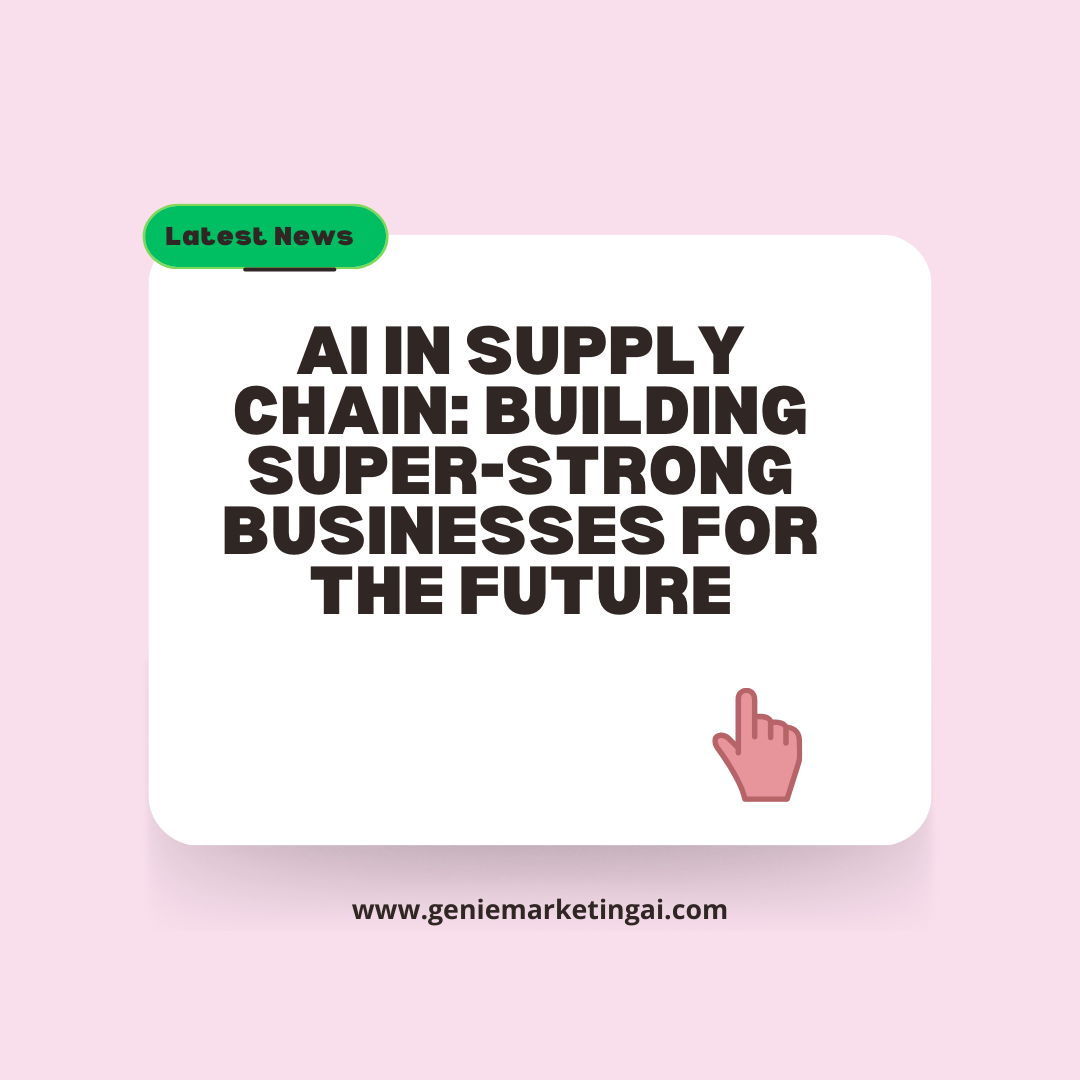Have you ever gone to the store excited to buy something, only to find an empty shelf? Or maybe you ordered a package that was delayed for weeks? It’s super frustrating! These are small signs of a huge global problem: stressed-out supply chains. In the last few years, things like the pandemic and big ships getting stuck have shown us that the system for moving stuff around the world can break easily. This costs companies billions of dollars and gives all of us a headache.
For a long time, businesses dealt with these problems after they happened. This is called being reactive. But that’s like trying to patch a leaky boat in the middle of a storm. Today, smart companies are using Artificial Intelligence (AI) to be proactive—to see the storm coming and prepare for it.
AI is like a super-brain that can look at the entire journey of a product, from the factory to your front door, and make it smarter, faster, and stronger. Let’s explore how AI supply chain technology is changing the game in logistics, forecasting, and planning.
The Big Squeeze: Why Supply Chains Are Struggling
Traditional supply chains have always had a few tricky spots, but today’s fast-paced world makes them even harder to manage.
Classic Pain Points
- The Bullwhip Effect: This is a funny name for a serious problem. Imagine a game of telephone. A customer buys a few extra sodas. The store manager sees this and orders a whole extra case. The warehouse sees that bigger order and orders a full pallet from the factory. The factory then orders tons of extra sugar and aluminum. A tiny change at one end creates a massive wave at the other, leading to wasted products and money.
- Sudden Changes in Demand: One viral video can make a toy the hottest item of the year overnight. Tastes change in a blink. It’s incredibly hard for humans to guess what will be popular next.
- Too Much or Too Little: When you guess wrong, you either end up with overstocking (a warehouse full of stuff nobody wants) or stockouts (empty shelves and disappointed customers).
Now, add in huge global disruptions like pandemics or bad weather, and you can see why the old ways of doing things with spreadsheets just don’t work anymore.
AI in Motion: Smarter, Faster, Cheaper Logistics
Logistics is the science of moving things from A to B. AI-powered logistics optimization is like giving your delivery fleet a massive intelligence boost.
Real-Time Smart Routing
Forget old paper maps or basic GPS. AI algorithms create the best delivery routes in real time. This “super-GPS” looks at live traffic, weather reports, and even specific delivery windows to find the most efficient path right now. The result? Big companies are cutting their fuel and delivery costs by 15-20% and getting packages to you faster.
Super-Smart Warehouses
A modern warehouse is a busy place. AI acts as the ultimate organizer.
- It designs the warehouse layout so the most popular items are easiest to grab.
- It tells workers or robots the fastest order to pick and pack items for your shipment.
- It can even predict when a forklift or a conveyor belt might break down, so it can be fixed before it causes delays. This is called predictive maintenance.
The Final Step: Last-Mile Delivery
The “last mile”—that final journey from the warehouse to your house—is the trickiest and most expensive part. AI helps by predicting delivery times with amazing accuracy, helping manage delivery drones and robots, and even learning your personal preferences, like if you prefer packages left by the back door.
No More Guessing: The Magic of AI Inventory Forecasting 🔮
Knowing exactly how much stuff to have on hand is a superpower. AI inventory forecasting makes this possible.
Sensing What’s Coming
Old-school forecasting just looked at past sales. AI is like a master detective. It uses machine learning to look at hundreds of clues at once:
- What’s trending on social media
- News reports and economic data
- Upcoming holidays or events
- Weather forecasts (people buy more soup when it’s cold!)
This “demand sensing” allows companies to see what people will want to buy with incredible accuracy, far better than traditional methods.
The Whole Picture: Multi-Echelon Inventory Optimization
Instead of each warehouse managing its own stock, AI looks at the entire network at once. It’s like a chess grandmaster, strategically placing inventory across the country where it’s most likely to be needed. This holistic view, called MEIO, ensures the right product is in the right place at the right time, preventing stockouts and saving money.
Planning for Success with an AI Crystal Ball
Demand planning is about making smart, long-term decisions. AI gives businesses the tools to look into the future with confidence.
Market Intelligence
Using a technology called Natural Language Processing (NLP), AI can read and understand thousands of news articles, blogs, and customer reviews every day. It can figure out if people are feeling good or bad about a product and spot new trends before they become mainstream.
Playing “What If?”: Scenario Planning
What if a big storm closes a major port? What if a key supplier has a problem? AI can run thousands of simulations to test how the supply chain would handle different disasters. This lets companies create backup plans (Plan B, C, and D) before a crisis happens, making them much stronger.
Building an Unbreakable Supply Chain
Supply chain resilience means being able to bend without breaking. AI is the key to creating supply chains that can handle any surprise.
- Early Warning System: AI can spot potential problems early, like a supplier who might be in financial trouble. This gives companies time to find a backup.
- Quick Responses: When something does go wrong, AI can instantly suggest solutions, like switching to another supplier or rerouting shipments around the problem area.
- Helping the Planet: A smarter supply chain is a greener one. Optimized routes mean less fuel is burned. Better forecasting means less waste from products that don’t sell.
How Does a Company Get Started with AI?
Jumping into AI doesn’t happen overnight. It’s a step-by-step journey.
- Start Small: A company should pick one specific problem to solve first, like forecasting a single product line. This is called a pilot project.
- Get Good Data: AI needs good, clean data to work its magic. Think of it like cooking: you need quality ingredients to make a great meal. The same is true for AI—garbage data in, garbage results out.
- Measure Everything: To know if it’s working, companies track things like cost savings, on-time delivery rates, and how often they run out of stock.
Real-World AI Wins
This isn’t just a dream for the future. Big companies are already using AI to get amazing results:
- A giant retailer used AI to reduce its extra inventory by millions of dollars while making sure popular items were always in stock.
- A global food company used AI demand sensing to improve its forecast accuracy by over 20%, meaning fresher food on shelves and much less waste.
- A major e-commerce company uses AI to optimize every single delivery, getting packages to customers faster and more efficiently than ever before.
What’s Next? The Future is Autonomous
AI in the supply chain is only getting started. The future is even more exciting.
- Self-Driving Supply Chains: Soon, AI systems will handle routine decisions on their own, like ordering new stock and managing deliveries with little to no human help.
- Digital Twins: Companies are building perfect virtual copies of their entire supply chain. They can test out new ideas and practice for disasters in this safe, digital world without any real-world risk.
- Smart Sensors (IoT): Billions of tiny sensors on packages, trucks, and ships will feed real-time information to AI systems, giving them a perfect view of where everything is at all times.
Your Advantage for Tomorrow Starts Today
AI is no longer science fiction. It’s a powerful tool that’s changing how business is done. By using AI for logistics optimization, inventory forecasting, and demand planning, companies can do more than just save money. They can build fast, smart, and resilient supply chains that are ready for anything.
The question is no longer if businesses should use AI, but how quickly they can begin. The journey to a smarter, stronger future is already underway.


